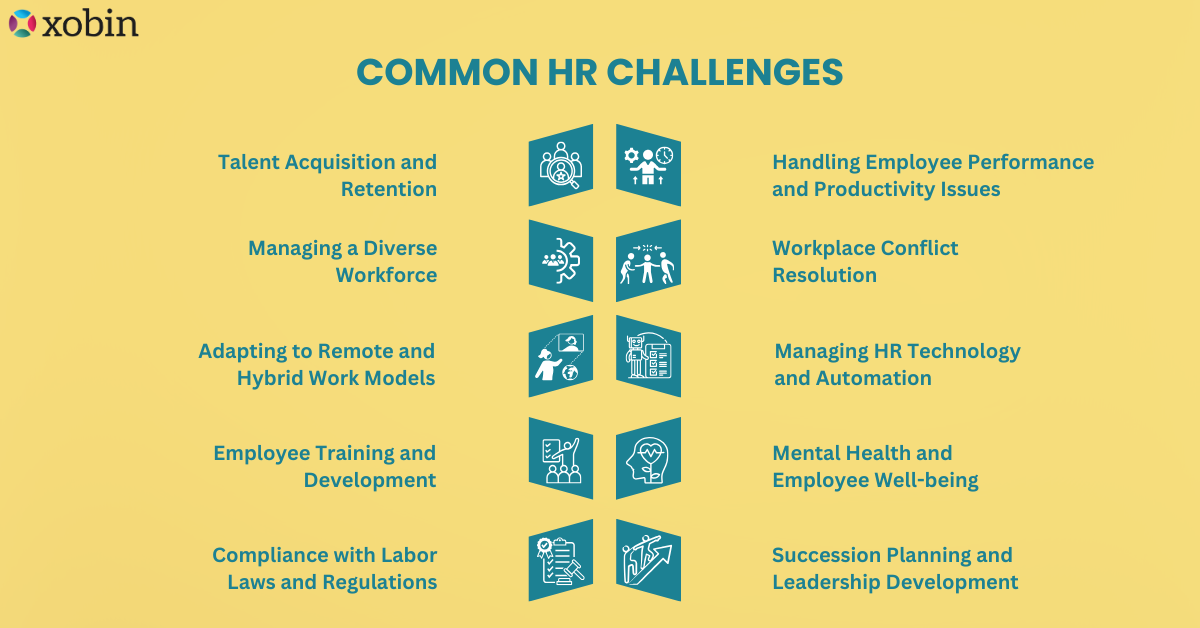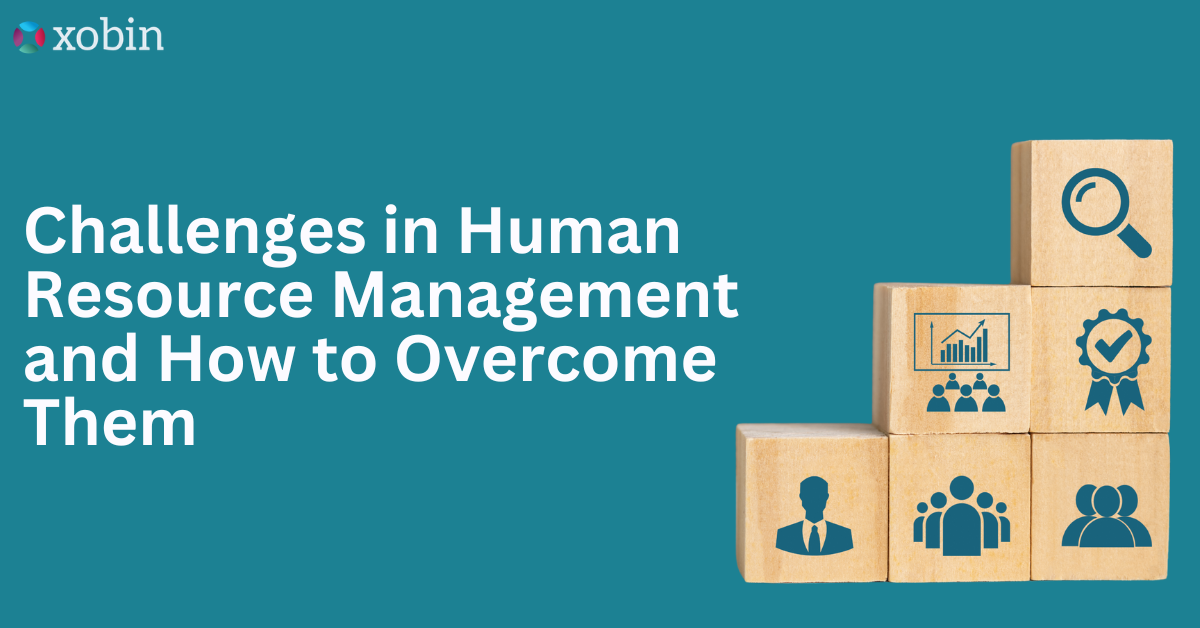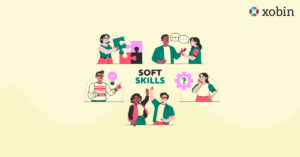Human Resource Management is at the heart of every successful organization. It ensures that businesses attract, develop, and retain the best talent while maintaining a positive and productive workplace culture. However, challenges in human resource management have become more complex due to changing work environments, technological advancements, and evolving employee expectations. In this blog, we will explore the major HR challenges organizations face today and provide actionable solutions to overcome them.
Table of Contents
Common HR Challenges and Solutions to Overcome Them

1. Talent Acquisition and Retention
Hiring the right talent and retaining skilled employees is one of the biggest challenges in human resource management. The job market is highly competitive, and candidates often have multiple job offers. Additionally, employees today expect more than just a salary. They seek career growth, work-life balance, and positive work culture. If organizations fail to meet these expectations, they experience high employee turnover.
How to Overcome It
- Use Pre-Employment Assessments: Cognitive Ability Tests, Personality Evaluation Tests, and Job-Specific Tests helps in evaluating a candidate’s skills and cultural fit before hiring.
- Build a Strong Employer Brand: Showcase company culture, career growth opportunities, and employee benefits for talent acquisition and retention
- Enhance Employee Engagement: Offer professional development, mentorship programs, and a positive work environment to improve retention.
2. Managing a Diverse Workforce
Diversity and inclusion are essential for fostering innovation and growth. However, managing a diverse workforce presents unique challenges. Differences in culture, language, and perspectives can lead to misunderstandings and workplace conflicts. Moreover, unconscious bias in hiring and promotion decisions can hinder diversity efforts. HR professionals must ensure that inclusivity is ingrained in the company’s policies and work culture.
How to Overcome It
- Implement Diversity and Inclusion Training: Educate employees on cultural sensitivity and unconscious bias.
- Create Inclusive Policies: Ensure hiring practices, promotions, and workplace norms support diversity.
- Use AI in Recruitment: Tools like Xobin eliminate bias by assessing candidates based on skills rather than personal characteristics.
- Use assessments to manage diverse teams: The Cultural Add Test and Emotional Intelligence Test ensure that employees can work well in diverse teams.
3. Adapting to Remote and Hybrid Work Models
The rise of remote and hybrid work models has transformed traditional workplace structures. However, maintaining productivity, ensuring clear communication, and fostering team collaboration in a remote setting can be difficult. Without the right strategies, remote employees may feel disconnected, leading to decreased engagement.
How to Overcome It
- Use Technology for Remote Hiring and Onboarding: Online assessments and automated video interviews help streamline virtual recruitment.
- Foster Communication: Encourage the use of collaboration tools like Slack, Zoom, or Microsoft Teams.
- Set Clear Expectations: Define remote work policies, productivity goals, and performance metrics.
- Evaluate employee productivity: Use the Time Management test and Communication Test to assess if employees can stay productive and self-motivated while working remotely.
4. Employee Training and Development
Keeping employees updated with the latest industry skills is essential for business growth. However, traditional training methods can be expensive, time-consuming, and ineffective if not tailored to individual learning needs. A lack of career development opportunities can also lead to employee dissatisfaction and higher turnover.
How to Overcome It
- Invest in Learning Management Systems (LMS): Offer online courses and microlearning modules.
- Encourage Continuous Learning: Provide incentives for certifications and skill development.
- Identify skill gaps: Use Skills Assessment Tools to find the skill gaps and personalize training accordingly.
5. Compliance with Labor Laws and Regulations
HR teams must comply with a wide range of labor laws, including wage regulations, workplace safety, and anti-discrimination policies. However, legal requirements vary by country and industry, making compliance a complex and time-consuming task. Failure to adhere to regulations can lead to costly lawsuits and reputational damage.
How to Overcome It
- Stay Updated with Legal Changes: Subscribe to HR legal newsletters or consult legal professionals.
- Automate Compliance Tracking: Use the best HR system to manage employee records and ensure policy adherence.
- Conduct Regular Audits: Review HR policies and documentation to ensure legal compliance.
- Assess decision-making: Use the Data-Driven Decision Making Test and Business Ethics Test to evaluate decision-making in ethical dilemmas.
6. Handling Employee Performance and Productivity Issues
Ensuring high employee performance is a key responsibility of HR. However, some employees struggle with motivation, unclear job roles or lack of direction. Without proper performance management strategies, businesses may experience low productivity, poor team morale and missed goals.
How to Overcome It
- Implement Performance Management Systems: Use data-driven insights to track and improve employee performance.
- Set Clear Goals and Feedback Mechanisms: Conduct regular performance reviews and offer constructive feedback.
- Recognize and Reward Employees: Incentivize high performers with bonuses, promotions, or recognition programs.
7. Workplace Conflict Resolution
Conflicts are inevitable in any workplace, whether they arise between employees, managers, or different departments. If not addressed properly, conflicts can lower morale, increase stress, and affect overall productivity. HR professionals need to mediate disputes and foster a positive work environment.
How to Overcome It
- Encourage Open Communication: Establish a transparent grievance redressal system.
- Offer Conflict Resolution Training: Equip managers with mediation skills.
- Promote a Positive Work Environment: Foster respect and teamwork through employee engagement activities.
- Conduct Conflict Resolution Assessments: Evaluate problem-solving skills and Negotiation Tests to determine how well employees handle disagreements and collaborate in teams.
8. Managing HR Technology and Automation
With the rise of HR technology, many companies struggle with implementing new systems, integrating different software, and training employees to use these tools effectively. Poorly managed HR technology can lead to inefficiencies and frustration among HR teams and employees.
How to Overcome It
- Choose User-Friendly recruitment Software: Platforms like Xobin simplify hiring and talent assessments.
- Provide Training on New Technologies: Educate employees on how to use HR tools effectively.
- Leverage AI for HR Processes: Automate repetitive tasks such as resume screening with ats and interview scheduling.
- Assess Adaptability Skills: Use the assessments to evaluate how quickly employees learn new systems.
9. Mental Health and Employee Well-being
Workplace stress, burnout, and mental health concerns are rising in today’s fast-paced work environments. When employees feel overwhelmed, their performance declines, leading to higher absenteeism and turnover rates. Many companies lack structured mental health support systems.
How to Overcome It
- Promote Work-Life Balance: Offer flexible working hours and mental health days.
- Introduce Employee Assistance Programs (EAPs): Provide counseling and wellness programs.
- Create a Supportive Culture: Encourage managers to prioritize employee well-being.
- Conduct Workplace Stress Assessment: use Stress Management Tests to measure stress levels and help HR implement wellness programs.
10. Succession Planning and Leadership Development
Many businesses struggle with leadership gaps when senior employees retire or leave the company. Without a clear succession plan, organizations risk losing valuable knowledge and experience, which can affect long-term stability and growth.
How to Overcome It
- Develop Leadership Training Programs: Offer mentorship and executive coaching.
- Use Talent Assessments: Identify high-potential employees using the Leadership Psychometric Test and Situational Judgment Test (SJT).
- Create Career Growth Opportunities: Encourage internal promotions to retain top talent.
Tackle HRM Challenges Efficiently with Xobin!
The challenges in human resource management are diverse and ever-evolving. However, with the right strategies and tools, HR professionals can overcome these obstacles and build a strong, engaged workforce.
At Xobin, we provide advanced skills testing and recruitment solutions to help businesses tackle these challenges in human resource management efficiently. Whether it’s talent acquisition or identifying skills gaps in your employees, Xobin empowers HR teams to make data-driven decisions and enhance their hiring process.
Are you ready to streamline your HR processes and overcome these challenges? Book a personalized demo and transform the way you hire talent!






